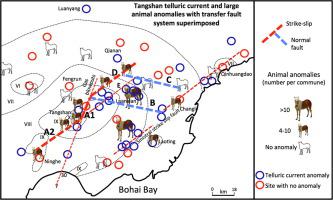Journal of Asian Earth Sciences ( IF 3 ) Pub Date : 2021-04-01 , DOI: 10.1016/j.jseaes.2021.104738 Euan Mearns , Didier Sornette

|
The geodynamics and faulting mechanism of the M7.8 Tangshan earthquake (China, 28th July 1976) are re-examined within a framework of a transfer fault complex that has strike slip, thrust and normal faulting components. The locations of the faults are conditioned by the locations of the 30 largest shocks (M > 5) of the sequence from 28th July to 27th November 1977. We find that the shocks are naturally arranged into three discrete time–space constrained sequences, and two linked transfer fault complexes are required to explain the data. We validate the transfer fault model by comparing the distribution of faults as we map them with the distribution of 247 M > 4 aftershocks that occurred from 1 September 1976 to 31 December 1979, the distribution of recent H2 and He soil gas anomalies from 756 sites spread across the extensive fault zone and the distribution of large animal behaviour and telluric current anomalies. We find a high degree of conformity between the transfer faults as we map them and these other data sets, with some degree of inconsistency that we use to refine the transfer fault model. Our main conclusion is that event 1 (M7.8) of the Tangshan earthquake occurred on the dextral strike slip leg of a transfer fault on the edge of the Bohai Bay Basin and as such is an integral part of the on-going evolution of that basin where a new active rifting phase may have begun during the Quaternary.



























 京公网安备 11010802027423号
京公网安备 11010802027423号